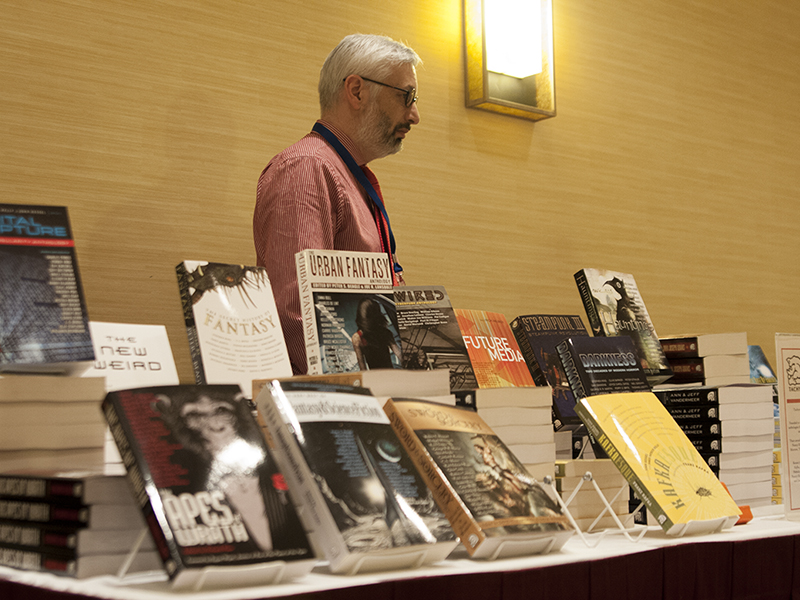
Thursday – Introductions
By Michael Rios
The first day of the 2013 Eaton Science Fiction Conference at the Marriott hotel in Riverside was a who’s who of science fiction. Writers from shows like “Battlestar Galactica,” “Star Trek” and even “Tron: Uprising” were all invited to the event, which began on April 11. From breakout sessions to public displays of science fiction works, the three-day conference featured it all.
According to some of the event coordinators, that was exactly the intent. As Sarah Allison, the director of the Eaton Conference Planning Committee, put it, the three-day event was essentially a way for UC Riverside to leave a memorable mark in the world of science fiction.
“We wanted to create a recognizable brand,” she stated in an interview with the Highlander.
I attended a few of breakout sessions in my time there. One of the lectures, entitled “Superhero Controversies in Comics and Television,” featured a heated discussion about some of the themes of shows like “Dr. Who” and “The Teenage Mutant Ninja Turtles.” For instance, Kimberly McMahon-Coleman of the University of Wollongong argued that the themes portrayed in the modern “Dr. Who” are misogynistic. According to her, the show does a poor job creating strong role models for the young women who watch the show. This was met by fierce criticism by some of the male audience members, who questioned the opinion of the presenter and argued that some of the female characters of the show were indeed strong female role models.
Other presenters included Toby Braden Johnson, a graduate student at UC Riverside. He gave a presentation that outlined a potentially racist representation of the prophet Muhammad in a “Ninja Turtles” comic. According to him, this was a controversy that went unnoticed and his intent was to let readers of the comic know.
But the conference wasn’t a solely lecture-filled event; it also featured a treasure trove of science fiction literary works including material from UCR’s Eaton Collection of Science Fiction and Fantasy. Other notable features included cinema memorabilia and even a working 3D printer. Essentially, the entire conference presented the many ways science fiction has been portrayed in the many forms of media.
The goal was to to bring together hundreds of science fiction aficionados from all over the globe in hopes of making UCR’s collection a more recognizable brand. Evidently it worked. As Allison put it, the first day was “successful.”
Friday – Narratives, Identities and Breaking Bad
By Rebecca Paredes
The Eaton Science Fiction Conference continued last Friday at the Marriott hotel in Riverside. I attended an early-morning presentation titled, “Mirror, Mirror: Intertextual Narratives of Power and Identity in Science Fiction Television,” which is a mouthful of a title but ended up being reasonably fascinating. Stanley Orr, an english professor at the University of Hawai’i, West O’ahu began the session with a sonorous reading from “The Night of the Burning Scripts,” an essay that covered the postcolonial aesthetics of John Kneubuhl in “The Wild, Wild West.”
The lectures were presented in an essayistic format. Orr and the following speaker, Craig Svonkin, from the Metropolitan State University of Denver, maintained a lively conversation during the freeform Q&A sessions following their lectures. Cheryl Edelson, an english professor from Chaminade University, made an enthralling presentation on Heisenberg’s identity in the hit TV series “Breaking Bad.” I wasn’t interested in watching the show until Edelson discussed the parallels between Walter White’s evolution into an iconic, beaker-bursting, science fiction baddie. A few tech troubles prevented Edelson from showing us specific clips, but her description of Heisenberg as a villain in the same vein (aesthetically and thematically) as Lex Luthor and Doctor Doom made up for the Marriott’s impossibly slow web connection.
My evening concluded at the Culver Center in Downtown Riverside, where experimental filmmaker Craig Baldwin presented his 1999 archived footage extravaganza, “Spectres of the Spectrum.” The film featured an avant-garde use of flashes, distorted images and high-pitched sounds (boops and beeps, naturally). It included satirical slant and explored the timeline of media’s evolution––which was one of the themes of the entire conference.
Saturday – A Goodbye Tribute
By Michael Rios
The third and final day of the conference served as a sort of tribute to some of the biggest pioneers in science fiction. It was a proper sendoff to what proved to be a successful event.
One of the most memorable lectures was an hour-long tribute to James Gunn, the notable science fiction author. Gunn himself was present at the lecture.
After a presentation by some of his former students and colleagues, Gunn spoke a little about his life and interest in science fiction literature. As he put it, his love for science fiction developed after accidentally stumbling into a collection of Tarzan novels his grandmother’s closet. He went on to address the crowd, inspiring them to find their own passions in life. “Things come along and you need to take advantage of them,” he advised.
The conference concluded with a special awards ceremony to honor some of the biggest names in science fiction. Stan Lee, co-creator of Marvel Comics was invited to the conference to receive the J. Lloyd Eaton Lifetime Achievement award. However, much to the dismay for the attendees, lecturers and even coordinators, Lee was unable to attend.
The other recipients of the same award were science fiction novelist Ursula K. Le Guin and Ray Harryhausen, creator of a type of stop-motion animation known as Dynamation. His work has been featured in films such as “Jason and the Argonauts” and “Mighty Joe Young.”
Sarah Allison reflected on the success of the Eaton Science Fiction Conference. “[It was] the best one yet,” she said.








